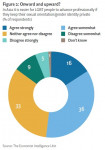CIOs’ grasp of broader business issues has improved
Closing the IT-business gap, an executive summary of research conducted by the Economist Intelligence Unit and sponsored by BMC Software, compares the results of an online survey of 452 respondents worldwide conducted in January with those of a similar survey done in October 2006. The latest research confirms an earlier finding that IT executives think they are more closely aligned with the “business side of the enterprise” than business executives perceive them to be. It also shows that CIOs must understand the business better·or overcome the perception that they do not understand it well enough·if they are to play a more vital role in formulating strategy.
Some of the report’s main findings appear below:
· IT-business alignment has improved over the past three years.
Executive respondents were asked to rate IT’s alignment with the broader business now compared with three years ago. Only 20% of non-IT respondents and 21% of IT respondents said that their companies were well aligned or perfectly aligned three years ago. Today, 40% of non-IT and 55% of IT executives say IT the two sides are aligned.
IT and business seem to be aligned most closely at technology and manufacturing firms. At IT and technology firms, 69% of respondents say that the business side of the organisation expresses and prioritises its IT needs effectively. Among executives in manufacturing, 82% say that this is true.
· Despite this progress, there remains a distinct “perception gap”: IT executives believe that they are more closely aligned to business objectives than business executives perceive them to be. When asked to give a snapshot of IT-business alignment, 61% of IT executives said their operations are well or perfectly aligned, but only 47% of non-IT respondents agreed. In percentage-point terms, that gap was similar to the difference found in the 2006 survey, in which 63% of IT respondents thought operations and IT were well or perfectly aligned, compared with just 49% of non-IT respondents.
· A growing majority of both IT and non-IT leaders expect that the CIO's role will expand, and that CIOs will soon become more involved in business improvement.
There is a growing expectation that CIOs will continue to become more influential within their organisations. In the 2006 survey, 50% of non-IT executives said it was somewhat or highly likely that within the next year the CIO’s role would expand to include more involvement in business improvement. This year the percentage rose to 65%.
Even so, when asked to whom the CIO or senior IT executive at their organisation reported, fewer respondents in both categories cited the CEO than in the previous study. Forty-three percent of IT respondents and 53% of non-IT respondents say that their CIO reports to their company’s CEO, compared with 59% and 62% respectively from the previous study.
· IT leaders remain accountable for the success of IT decisions, yet rarely have the final say over major IT investment decisions. Despite increasing alignment between IT and business leaders, IT leadership still lacks authority over major IT investments, although it remains accountable for the success of IT initiatives. In both the 2006 and 2008 surveys, 64% of non-IT executives said that at their companies the final say over strategic IT investment decisions rested with the CEO and the executive team.
· Both IT and non-IT executives seem confident that technology will eventually narrow the alignment gap. Forty-four percent of IT respondents and 50% of non-IT respondents cited “business service management” as a technology that IT could use to become more business-focused. Another option, “improved process automation technology”, was cited by 50% of IT respondents and 44% of non-IT respondents. That made “business service management” this year’s top choice for non-IT executives and the second choice for IT respondents. In 2006, business service management and project/portfolio management were the top technologies cited by both groups.
“Business and IT executives are now closer to agreeing on how their respective goals should harmonise,” says Debra D’Agostino, Senior Technology Editor at the Economist Intelligence Unit. “This is encouraging, but considerable work remains to be done. Better communication and consensus must be reached on key IT performance measurements. Near- and long-term IT objectives also should be mapped to business goals. Executives from both groups must continue to work together to understand better their counterparts’ challenges and opportunities as well as their objectives.”
Closing the IT-business gap
is available free of charge at www.eiu.com/sponsor/bmc/italignment
About the survey
The survey was carried out in January 2008 among 452 respondents worldwide (169 based in Europe, 116 in North America, 129 in Asia-Pacific and 38 in the rest of the world). Of the global respondents, 48% held IT roles and 41% were C-level (e.g. CEO, CFO, CIO) executives. Thirty-nine percent of the respondents' companies had annual sales of more than US$1bn, and 45% reported annual sales of less than US$500m. The earlier survey was conducted in October 2006 among 565 respondents.
About the Economist Intelligence Unit
The Economist Intelligence Unit is the business information arm of The Economist Group, publisher of The Economist. Through our global network of more than 700 analysts and contributors, we continuously assess and forecast political, economic and business conditions in 200 countries. As the world's leading provider of country intelligence, we help executives make better business decisions by providing timely, reliable and impartial analysis on worldwide market trends and business strategies.
웹사이트: http://www.eiu.com
연락처
Joanne McKenna, Press Liaison, +44 (0)20 7576 8188; 이메일 보내기
Debra D’Agostino, Senior Technology Editor, 212-698-9751 이메일 보내기
이 보도자료는 Economist Intelligence Unit가(이) 작성해 뉴스와이어 서비스를 통해 배포한 뉴스입니다. 뉴스와이어는 편집 가이드라인을 준수합니다.




